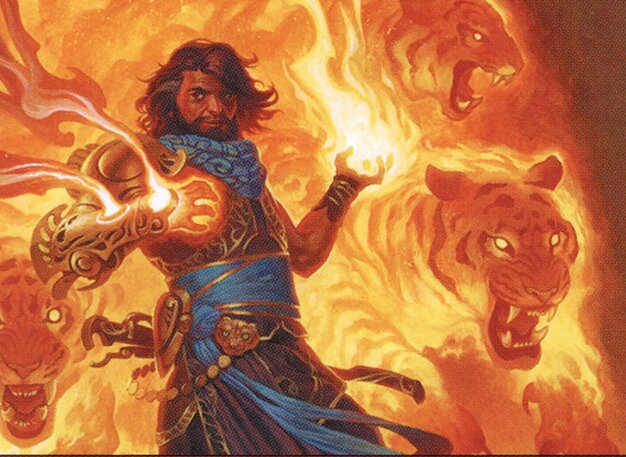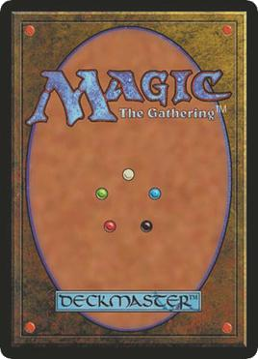 Art by Steve Prescott
Art by Steve PrescottThis cube is all about turning downsides into upsides. And it does so through combining cards to create synergy. And while there are no game winning combos present (only aggro, midrange, and control), the best decks are built to be more than the sum of their parts.
The most prevalent way to do this is by utilizing the graveyard. Graveyard hate is limited to allow these synergies to operate relatively safely.
Archetypes
Archetypes are not tied to color pairs the way you’d see in retail draft. Instead, you’ll find support across multiple colors and many archetypes overlap with each other.
Graveyard Value


 /
/ Self-Mill
Self-Mill
This deck generates value by using its graveyard as an extension of its hand. It usually tries to go bigger than its opponent and win the game with an overwhelming amount of card advantage, ensuring it always has the perfect card.
Jace, Wielder of Mysteries
This deck takes the form of either a control or midrange deck which plays lots of card draw or self-mill and then eventually wins the game by milling itself out.
Delirium
The delirium deck often takes the form of a midrange deck, disrupting its opponent's plan while beating down with an over-statted creature. It can also play more aggressively with the inclusion of red. It should prioritize enchantment and artifact card types to increase its chances of achieving delirium.
Splashing for Red
Aristocrats


 /
/ Aggrocrats
Aggrocrats
This deck plays like a typical aggro deck, but utilizes death triggers for additional reach and recurring creatures for value. It attacks recklessly, not caring if it's creatures die. Lurrus is a natural fit as many of the pieces in the deck are 2 mana value or less.
Attrition Aristocrats
This midrange deck plays lots of removal and grinds its opponent out with incremental value generated by looping sacrifice triggers. It keeps the value going with repeatable token generators.
Splashing For Green
Tokens

 /
/
The token deck is a typical go-wide aggressive deck. It doesn't really require any payoffs as generating an army of tokens is often good enough. However, drafters might attempt to generate additional value from their tokens through sacrifice cards or token specific value generators.
Splashing for Green
Lands


 Big Value
Big Value
This deck loops fetch lands from the graveyard by recurring them every turn to ensure it never misses a land drop. It keeps itself alive by playing counter spells and removal. Then it takes over the game with powerful expensive spells.
Stompy
This deck leans more aggressive than its blue counterpart. It ramps out powerful threats early while generating additional value from its lands, either from discarding/recurring them or from landfall triggers.
Field of the Dead
The cube supports a Field of the Dead package that fits nicely into a deck which plays land recursion, land tutors, and other pieces to gain value. These decks spend the early game ramping, then win with Field of the Dead triggers in the late game. As Field of the Dead requires many different land names, this deck ends up as 5 colors. When drafting with Field of the Dead, be sure to prioritize dual lands.
Discard Matters


 /
/ Aggro Discard
Aggro Discard
This deck plays cheap recursive creatures that can be pitched for "free" to gain additional card advantage from looting effects. These same creatures give the deck staying power against one-for-one removal.
Flashback
This tempo deck gets double the value out of its spells by discarding them for value and then flashes them back.
Splashing for Green
Splashing into green pushes it into a midrange land recursion or self-mill deck.
Control


 /
/ Splashing for Red
Splashing for Red
The control deck play a wealth of removal, counterspells, and card draw. It filters through its deck to find the right answers at the right time and then inevitably wins with a ham sandwich.
Packages
These are groupings of cards that synergize, but don’t have enough support to fill out an entire deck. These can compliment another deck or act as a backup plan.
Artifacts
Winota


+1/+1 Counters


Agatha's Soul Cauldron

 /
/
White now has access to more cards that synergize with the other main archetypes in the cube. The goal is to pull drafters into white for reasons other than just aggressive creatures and removal.
Green's 1-mana ramp options have been reduced and replaced with 2-mana variants. The goal is increase the difficulty of ramping out a 3-drop on turn 2 and also to add more synergistic variety to the ramp cards. To accommodate this change, green's creature suite has been re-tooled to reduce the number of 3-drops.
Black has received a power boost and support for a reanimator archetype. The reanimation has been limited to turn 3 in order to minimize non-games.

